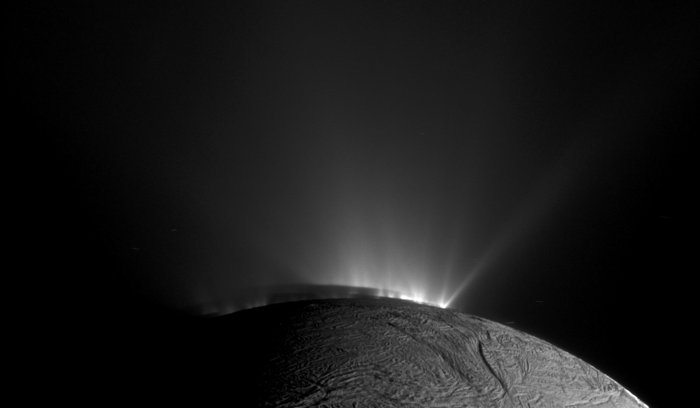As soon as the Cassini-Huygens mission arrived the Saturn system in 2004, it began to send back a number of startling discoveries. One of the biggest was the discovery of plume activity around the southern polar region of Saturn’s moon Enceladus’, which appears to be the result of geothermal activity and an ocean in the moon’s interior. This naturally gave rise to a debate about whether or not this interior ocean could support life.
Since then, multiple studies have been conducted to get a better idea of just how likely it is that life exists inside Enceladus. The latest comes from the University of Washington’s Department of Earth and Space Sciences (ESS), which shows that concentrations of carbon dioxide, hydrogen and methane in Enceladus’ interior ocean (as well as its pH levels) are more conducive to life than previously thought.
The research team consisted of Lucas Fifer, a UW doctoral student with the ESS, and David Catling and Jonathan Toner (a researcher and research assistant professor with the ESS, respectively). As they indicated in study, the presence of such high concentrations of these elements and an “Earth-like” pH level in the water could provide the necessary fuel for living microbes.

These similarities in pH (as well as salinity and temperatures) with Earth’s oceans are what has made Enceladus’ subsurface ocean a subject of interest to scientists. These similarities were first noticed shortly after Cassini‘s began studying the plumes that periodically erupt from the southern pole at speeds of up to about 1300 km/h (800 mph).
However, Fifer and colleagues found that the plumes themselves aren’t chemically the same as the ocean from which they erupt since the eruption process itself changes their composition. This is due to a process where the plume undergoes a separation of gases (known as “fractionation”), which allows some components of the plume to erupt while others are left behind.
In this respect, the plumes provide an “imperfect window” into the composition of Enceladus’ subsurface ocean. With this in mind, the team analyzed data from the Cassini mission using a computer simulation that accounted for the effects of fractionation. What this revealed was that previous studies had underestimated the presence of hydrogen, methane and carbon dioxide in the ocean.
These high levels of carbon dioxide are also a possible indication of a lower and more Earthlike pH level in the ocean of Enc
“It’s better to find high gas concentrations than none at all. It seems unlikely that life would evolve to consume this chemical free lunch if the gases were not abundant in the ocean… Although there are exceptions, most life on Earth functions best living in or consuming water with near-neutral pH, so similar conditions on Enceladus could be encouraging. And they make it much easier to compare this strange ocean world to an environment that is more familiar.”

Fife and his colleagues also acknowledge that these high concentrations of gases could indicate a lack of living organisms to consume them. However, that does not necessarily mean Enceladus is devoid of life, only that organisms may not be abundant enough to consume all the available chemical energy. In the meantime, these gas concentrations can be used to place an upper limit for certain types of life inside Enceladus.
Thanks to the data provided by Cassini, we not only know about Enceladus’ ocean but also the types of gases, salts and organic compounds that are present there. By studying how the composition of the moon’s plumes changes, future missions to Enceladus could teach us even more about this ocean and everything in it.
“Future spacecraft missions will sample the plumes looking for signs of life, many of which will be affected just by the eruption process,” Fife added. “So, understanding the difference between the ocean and the plume now will be a huge help down the road.”
The results of this study will be presented at the 2019 Astrobiology Science Conference (AbSciCon2019), an annual conference hosted by the American Geological Union (AGU) that will be taking place from June 24th to June 28th this year in Bellevue, Washington. The theme of this year’s conference will be “Understanding and Enabling the Search for Life on Worlds Near and Far.”
Further Reading: UWNews

